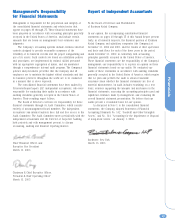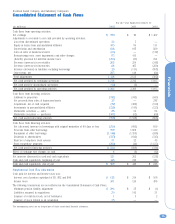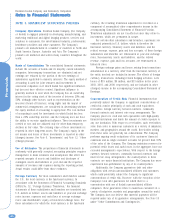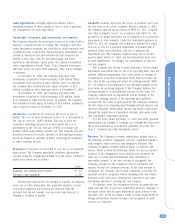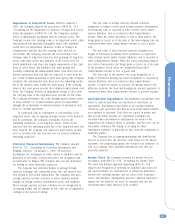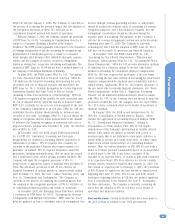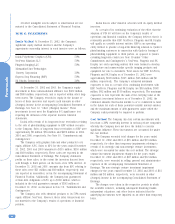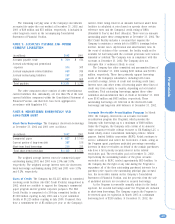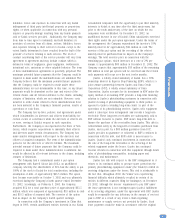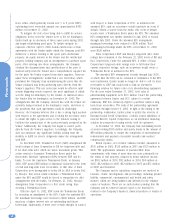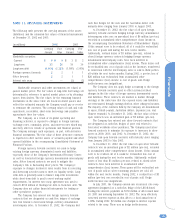Kodak 2002 Annual Report Download - page 49
Download and view the complete annual report
Please find page 49 of the 2002 Kodak annual report below. You can navigate through the pages in the report by either clicking on the pages listed below, or by using the keyword search tool below to find specific information within the annual report.
Financials
49
SFAS 143 effective January 1, 2003. The Company is currently in
the process of evaluating the potential impact that the adoption of
the recognition provisions of SFAS 143 will have on its
consolidated financial position and results of operations.
Effective January 1, 2002, the Company adopted the provisions
of EITF Issue No. 01-09, “Accounting for Consideration Given by a
Vendor to a Customer (Including a Reseller of the Vendor’s
Products).” The EITF provides guidance with respect to the statement
of earnings classification of and the accounting for recognition and
measurement of consideration given by a vendor to a customer,
which includes sales incentive offers labeled as discounts, coupons,
rebates and free products or services as well as arrangements
labeled as slotting fees, cooperative advertising and buydowns. The
adoption of EITF Issue No. 01-09 did not have a material impact on
the Company’s Consolidated Statement of Earnings.
In June 2002, the FASB issued SFAS No. 146, “Accounting
for Costs Associated with Exit or Disposal Activities.” SFAS No.
146 addresses the financial accounting and reporting for costs
associated with exit or disposal activities and supercedes the
EITF Issue No. 94-3, “Liability Recognition for Certain Employee
Termination Benefits and Other Costs to Exit an Activity
(including Certain Costs Incurred in a Restructuring).” SFAS No.
146 requires recognition of the liability for costs associated with
an exit or disposal activity when the liability is incurred. Under
EITF 94-3, a liability for an exit cost was recognized at the date
of the Company’s commitment to an exit plan. SFAS No. 146 also
establishes that the liability should initially be measured and
recorded at fair value. Accordingly, SFAS No. 146 will impact the
timing of recognition and the initial measurement of the amount
of liabilities the Company recognizes in connection with exit or
disposal activities initiated after December 31, 2002, the effective
date of SFAS No. 146.
In November 2002, the FASB issued FASB Interpretation
No. 45 (FIN 45), “Guarantor’s Accounting and Disclosure
Requirements for Guarantees, Including Indirect Guarantees of
Indebtedness of Others.” FIN 45 requires that a liability be
recorded in the guarantor’s balance sheet upon issuance of a
guarantee. In addition, FIN 45 requires disclosures about the
guarantees, including indemnifications, that an entity has issued
and a rollforward of the entity’s product warranty liabilities. The
Company will apply the recognition provisions of FIN 45
prospectively to guarantees issued or modified after December 31,
2002. The disclosure provisions of FIN 45 are effective for
financial statements of interim periods or annual periods ending
after December 15, 2002. See Note 1 under “Warranty Costs” and
Note 10, “Commitment and Contingencies.” The Company is
currently in the process of evaluating the potential impact that
the adoption of the recognition provisions of FIN 45 will have on
its consolidated financial position and results of operations.
In November 2002, the Emerging Issues Task Force reached
a consensus on EITF Issue No. 00-21, “Accounting for Revenue
Arrangements with Multiple Deliverables.” EITF Issue No. 00-21
provides guidance on how to determine when an arrangement that
involves multiple revenue-generating activities or deliverables
should be divided into separate units of accounting for revenue
recognition purposes, and if this division is required, how the
arrangement consideration should be allocated among the
separate units of accounting. The guidance in the consensus is
effective for revenue arrangements entered into in fiscal periods
beginning after June 15, 2003. The Company is currently
evaluating the effect that the adoption of EITF Issue No. 00-21
will have on its results of operations and financial condition.
In December 2002, the FASB issued SFAS No. 148,
“Accounting for Stock-Based Compensation – Transition and
Disclosure,” which amends SFAS No. 123, “Accounting for Stock-
Based Compensation.” SFAS No. 148 provides alternative methods
of transition for a voluntary change to the fair value based
method of accounting for stock-based employee compensation.
SFAS No. 148 also requires that disclosures of the pro forma
effect of using the fair value method of accounting for stock-based
employee compensation be displayed more prominently and in a
tabular format. Additionally, SFAS No. 148 requires disclosure of
the pro forma effect in interim financial statements. See “Stock-
Based Compensation” within Note 1, “Significant Accounting
Policies” for the additional annual disclosures made to comply
with SFAS No. 148. As the Company does not intend to adopt the
provisions of SFAS No. 123, the Company does not expect SFAS
No. 148 to have a material effect on its results of operations or
financial condition.
In January 2003, the FASB issued Interpretation No. 46
(FIN 46), “Consolidation of Variable Interest Entities,” which
clarifies the application of Accounting Research Bulletin (ARB)
No. 51, “Consolidated Financial Statements,” relating to
consolidation of certain entities. First, FIN 46 will require
identification of the Company’s participation in variable interest
entities (VIE), which are defined as entities with a level of
invested equity that is not sufficient to fund future activities to
permit them to operate on a stand alone basis, or whose equity
holders lack certain characteristics of a controlling financial
interest. Then, for entities identified as VIE, FIN 46 sets forth a
model to evaluate potential consolidation based on an assessment
of which party to the VIE, if any, bears a majority of the
exposure to its expected losses, or stands to gain from a majority
of its expected returns. FIN 46 is effective for all new variable
interest entities created or acquired after January 31, 2003. For
VIE created or acquired prior to February 1, 2003, the provisions
of FIN 46 must be applied for the first interim or annual period
beginning after June 15, 2003. FIN 46 also sets forth certain
disclosures regarding interests in VIE that are deemed significant,
even if consolidation is not required. See Note 6, “Investments,”
for these disclosures. The Company is currently evaluating the
effect that the adoption of FIN 46 will have on its results of
operations and financial condition.
Reclassifications Certain reclassifications have been made to
the prior periods to conform to the 2002 presentation.


